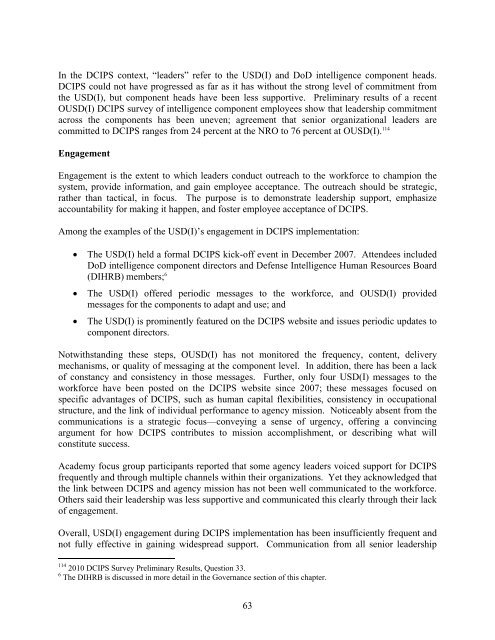Report - Government Executive
Report - Government Executive
Report - Government Executive
You also want an ePaper? Increase the reach of your titles
YUMPU automatically turns print PDFs into web optimized ePapers that Google loves.
In the DCIPS context, “leaders” refer to the USD(I) and DoD intelligence component heads.<br />
DCIPS could not have progressed as far as it has without the strong level of commitment from<br />
the USD(I), but component heads have been less supportive. Preliminary results of a recent<br />
OUSD(I) DCIPS survey of intelligence component employees show that leadership commitment<br />
across the components has been uneven; agreement that senior organizational leaders are<br />
committed to DCIPS ranges from 24 percent at the NRO to 76 percent at OUSD(I). 114<br />
Engagement<br />
Engagement is the extent to which leaders conduct outreach to the workforce to champion the<br />
system, provide information, and gain employee acceptance. The outreach should be strategic,<br />
rather than tactical, in focus. The purpose is to demonstrate leadership support, emphasize<br />
accountability for making it happen, and foster employee acceptance of DCIPS.<br />
Among the examples of the USD(I)’s engagement in DCIPS implementation:<br />
• The USD(I) held a formal DCIPS kick-off event in December 2007. Attendees included<br />
DoD intelligence component directors and Defense Intelligence Human Resources Board<br />
(DIHRB) members; 6<br />
• The USD(I) offered periodic messages to the workforce, and OUSD(I) provided<br />
messages for the components to adapt and use; and<br />
• The USD(I) is prominently featured on the DCIPS website and issues periodic updates to<br />
component directors.<br />
Notwithstanding these steps, OUSD(I) has not monitored the frequency, content, delivery<br />
mechanisms, or quality of messaging at the component level. In addition, there has been a lack<br />
of constancy and consistency in those messages. Further, only four USD(I) messages to the<br />
workforce have been posted on the DCIPS website since 2007; these messages focused on<br />
specific advantages of DCIPS, such as human capital flexibilities, consistency in occupational<br />
structure, and the link of individual performance to agency mission. Noticeably absent from the<br />
communications is a strategic focus—conveying a sense of urgency, offering a convincing<br />
argument for how DCIPS contributes to mission accomplishment, or describing what will<br />
constitute success.<br />
Academy focus group participants reported that some agency leaders voiced support for DCIPS<br />
frequently and through multiple channels within their organizations. Yet they acknowledged that<br />
the link between DCIPS and agency mission has not been well communicated to the workforce.<br />
Others said their leadership was less supportive and communicated this clearly through their lack<br />
of engagement.<br />
Overall, USD(I) engagement during DCIPS implementation has been insufficiently frequent and<br />
not fully effective in gaining widespread support. Communication from all senior leadership<br />
114 2010 DCIPS Survey Preliminary Results, Question 33.<br />
6 The DIHRB is discussed in more detail in the Governance section of this chapter.<br />
63













